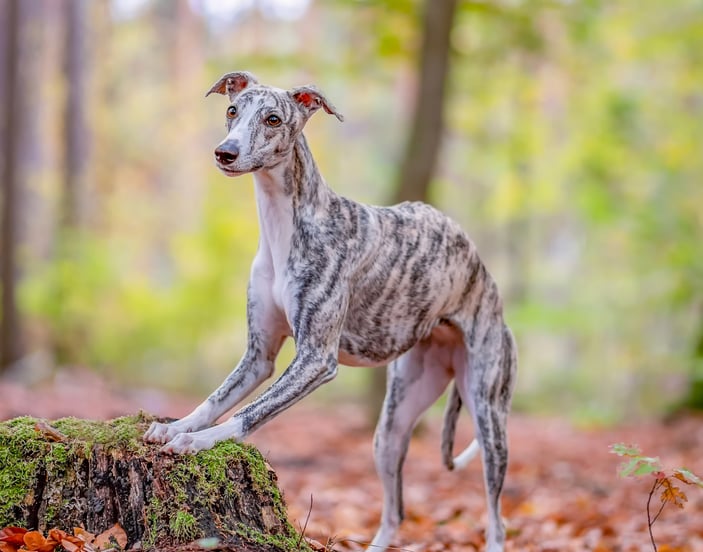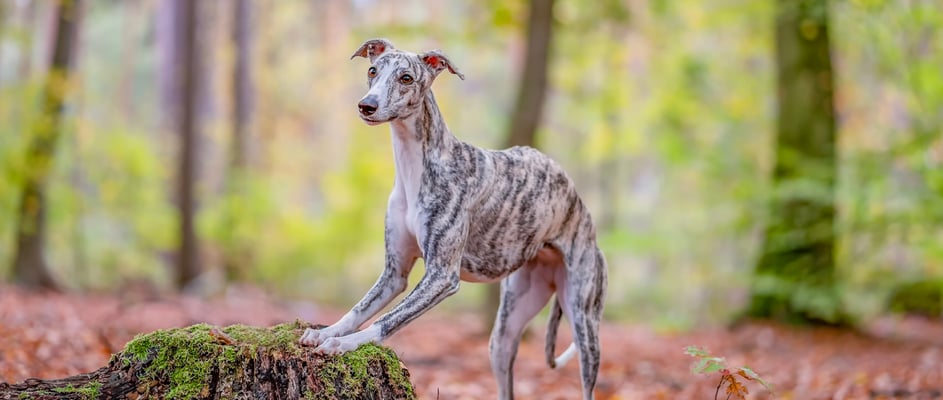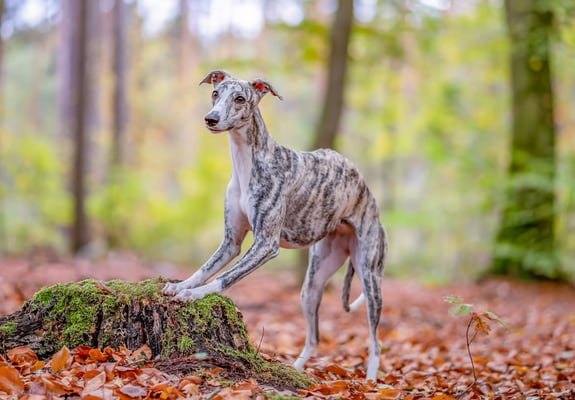The guide to owning a Greyhound.
Want to know everything there is to know about training your Greyhound puppy? Submit your email below, and we’ll send you a one-stop guide on all things puppy training!
Jump to:
Stats at a glance.
History of the Greyhound.
The Greyhound is more than just a dog breed – it’s a piece of ancient history. Often described as one of the oldest breeds, these elegant hounds have roots stretching back thousands of years.
Royals, hunters, and regular people have had a longstanding affection for these dogs. They are also a fascination for artists with the Greyhound’s regal appearance, being a kind of "muse".
In olden times, they were prized for their amazing speed and used for coursing and chasing wild game.
Today, racing Greyhounds are still recognised for their swift track racing, but many of these retired racing Greyhounds find new lives as cherished family companions.
If you’re curious about other sizable pups, check out our brief overview of big dog breeds in the UK.
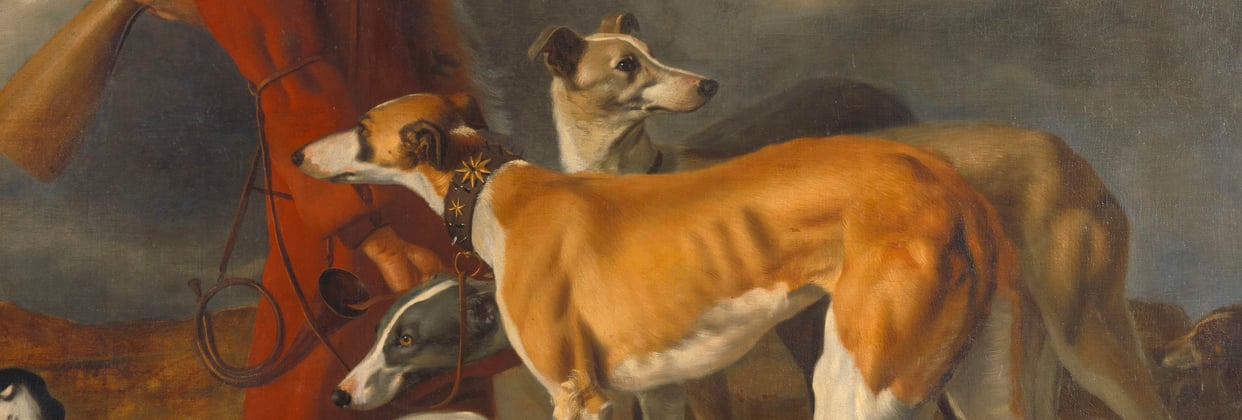

How much is a Greyhound puppy (UK)?
If you’re seeking a Greyhound dog pup in the UK, you may find them in the £200–£1,500 range, depending on factors like pedigree and breeder reputation.
But there’s another wonderful option to consider: rescue Greyhounds. Many Greyhounds make great pets after their careers.
Adoption fees can be much lower, and you’ll have the rewarding chance to offer a deserving companion dog a second shot at happiness.
If this is your first pup, you might also enjoy our tips on how to socialise your puppy for a smoother transition into family life.
When contacting breeders, look for ones who:
Show genuine concern for matching the right Greyhound with the right family.
Provide full Greyhound dog breed information and health test results.
Encourage you to meet the puppy’s parents.
Ask lots of questions about your home and lifestyle.
Colours and coat types.
While many think of Greyhounds as sleek and always grey (inspired by their name), they actually come in a range of striking shades, such as brindle, fawn, black, white, and the classic shade of “blue.”
Their single-layer coat is short, smooth, and easy to maintain, requiring only a light brush once or twice a week.
For more fascinating insight on grey-coloured coats, you can read our guide to grey dog breeds.





Size and weight.
How big does a Greyhound get?
These large breed dogs might look tall and slender, but they’re built like sprinters for top speeds. A male Greyhound often stands around 68–76cm at the shoulder, while females may be a bit smaller.
Males typically weigh 30–40 kg, and females 27–34 kg. Despite their height, they’re sometimes called “couch potatoes,” thanks to their calm nature at home.
Temperament.
Greyhounds are affectionate souls who thrive on companionship but can also be a touch aloof with new faces at first.
Those big eyes might make them look dreamy, but they’re surprisingly alert. This sighthound breed has strong chase instincts, so small critters in the garden may become objects of curiosity.
On the plus side, Greyhounds can be prone to short bursts of energy followed by luxurious naps on your sofa.
Possibly the biggest surprise is how gentle they can be with children and family members.
Do Greyhounds make good pets?
Yes. Greyhounds make great pets because they’re loving, calm indoors, and typically wonderful as family pets. Once they’ve had their daily run or brisk walk, they’re content to lounge in comfy spots – so you might catch them snuggling under blankets.
Are Greyhounds good with kids?
Yes, they are typically good with children if introduced properly. Like all domestic dogs, it’s wise to supervise interactions and teach kids how to greet, pat, and play gently, especially because of the Greyhound’s lean physique.
Are Greyhounds good with cats?
Many do fine with cats, but a Greyhound will chase if its prey drive kicks in suddenly.
Homes with cats should consider a calmer or previously “cat-tested” retired racing Greyhound. Early introductions and proper boundaries can help them live harmoniously.
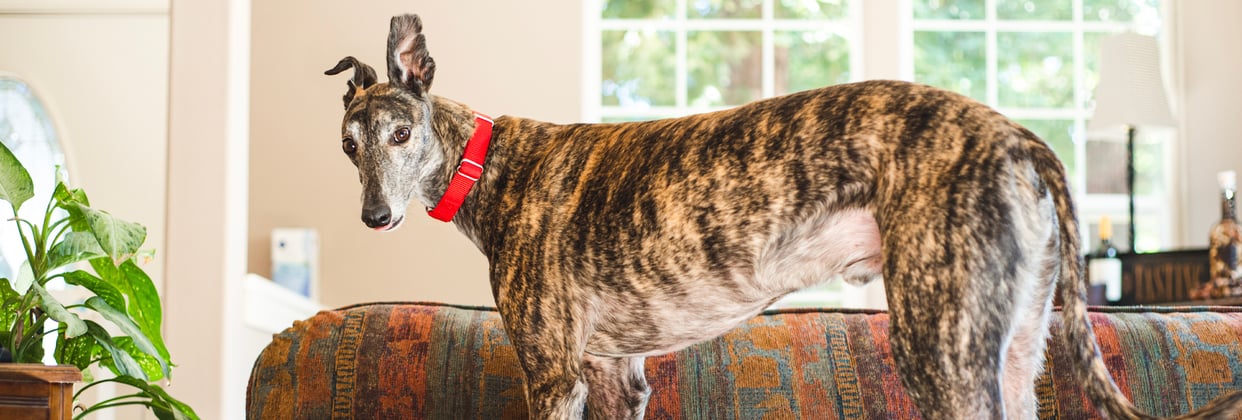

Behaviour.
Do Greyhounds suffer from separation anxiety?
Being quite people-oriented, many Greys aren’t delighted to be left alone for long stretches. They can be quite sensitive, so watch for signs of upset. If you’re concerned, our post on separation anxiety offers practical tips.
Can Greyhounds be left alone?
Yes, but only for short periods of time. They may manage 4–6 hours if they’ve had a brisk walk and a comfortable place to retreat. A pet sitter or dog walker can really help, particularly if you have a boisterous young puppy or a newly adopted rescue Greyhound still settling in.
Can Greyhounds live in apartments?
Surprisingly, yes. They’re quiet, don’t take up too much space (vertically they do, horizontally not so much!), and appreciate soft spots to lounge. They just need a daily walk or two, plus a chance for a controlled sprint every so often.
Do Greyhounds bark a lot?
These deep-chested pups are typically calm and not as chatty as some breeds.
Of course, all dogs can vocalise if they’re bored or anxious, but the Greyhound bark is less frequent than you might expect from many other canine companions.
Training a Greyhound.
Training a Greyhound isn’t about being strict—it’s about building trust. These graceful dogs might look reserved at first, but they’re surprisingly eager to please once they feel safe and settled.
Whether you’ve adopted a retired racer or brought home a pup, patience and kindness go a long way.
They respond best to calm, consistent routines and plenty of praise (plus the occasional snack doesn’t hurt either).


Are Greyhounds smart?
Yes, though they can be independent-minded due to their heritage as breeds originally used for hunting by sight.
Some may appear stubborn or distracted if they spot something moving in the distance. Reward-based training with gentle cues (and treats!) works best so they feel motivated. Loud scolding can hurt their sensitive spirit, so keep it positive.
Shedding and grooming.
They have a short, sleek coat that’s easy to maintain, making grooming a simple task for most owners.
How often should I brush my Greyhound?
Once or twice weekly will help remove loose hair and keep them clean. An occasional wipe with a damp cloth or a gentle bath using dog-friendly shampoo (see "How to Bathe a Dog") can keep that coat fresh and shiny.
Exercise and mental stimulation.
Although Greyhounds are prone to short, intense bursts of speed, they don’t need hours of strenuous exercise.
A balanced amount of exercise each day – typically 30–60 minutes – will do the trick. A fenced-in area or secure park is ideal for a zoomie or two.
Outside of their bursts, Greyhounds are content with leisurely walks and sunny naps.
They also appreciate mental enrichment like puzzle toys or gentle sniff-and-search games. Remember, Greyhounds will chase, so outdoor spaces must be secure, and you may need a muzzle until you’re confident they won’t be startled into sprinting down the road.
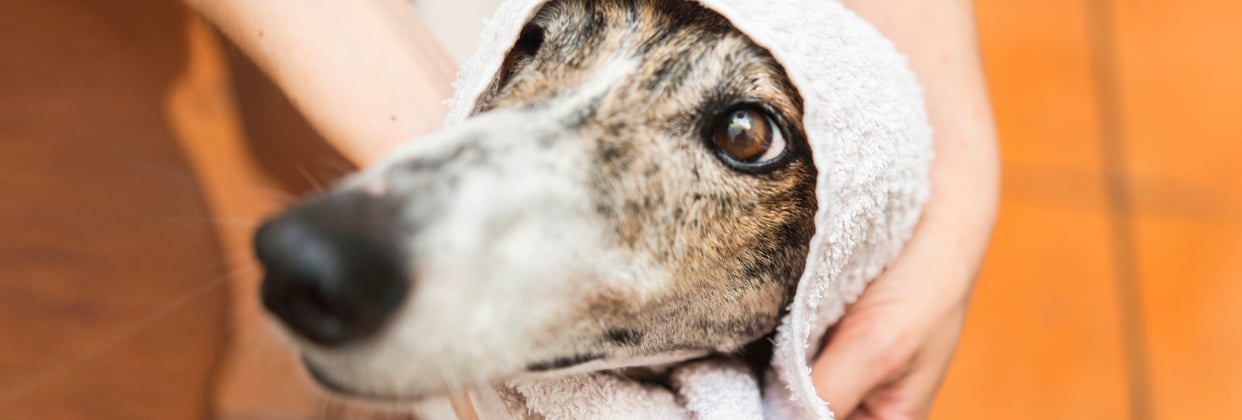

Feeding and nutrition.
A healthy Greyhound is a happy one. Aim for high-quality dog food scaled to weight, age, and activity level. With their lean figures, you’ll want to keep an eye on portion sizes, as too much weight can stress those deep-chested breeds.
Greyhounds can be prone to bloat, so dividing food into two daily meals is often recommended.
Common health issues in Greyhounds.
Below is a brief table of conditions that Greyhounds are prone to, along with approximate UK costs (these figures can vary by location and vet practice):
If you spot anything unusual, always speak to your veterinary professional. Early support leads to more healthy dogs and fewer surprises.
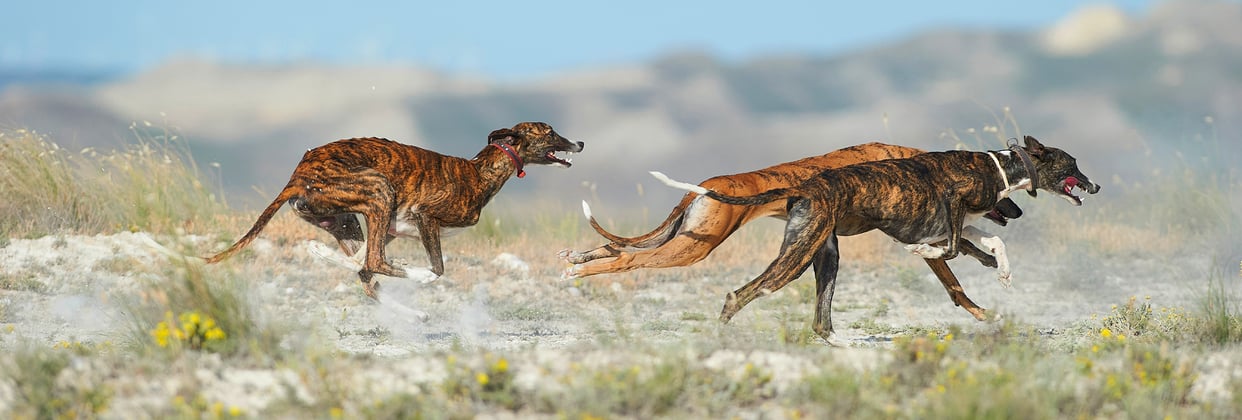

Pet insurance for Greyhounds.
Because Greyhounds are large breed dogs with a deep chest and a unique athletic background, having comprehensive coverage is a wise investment.
You can read more at our Greyhound pet insurance page. Our plans include:
Lifetime cover for chronic issues*
24/7 access to vet advice
Free behaviour and nutrition consultations
Support and peace of mind – so you can focus on enjoying life with your noble companion
*Exclusions such as pre-existing conditions may apply.
